The form of ribbonwork in this tutorial is an art used in Straight Dance and Southern Cloth outfits. This style is done by several tribes including Osage and Ponca.
This tutorial is for the cut and tuck method with a template.
Making the design and cutting the template is probably a whole tutorial by itself! For my ribbonwork, I use metal templates. The pattern shown below is done using 2 different metal templates.
When I first attempted ribbonwork, I was in awe of the details of the designs. After you learn the basic concepts of how ribbonwork is make, however, the process is quite simple.
You are layering or singling stripes of ribbons on top of each other to product a design.
Above is the base design I started with. As I progressed the design did change slightly.
Using this design I was able to cut the 2 metal templates needed to make the ribbons.

These two templates are cut out of metal flashing. You can find this material at your local home improvement store. Ask for the metal flashing used in roof repairs.
With these templates you can create the individual ribbons that will be layered to create the pattern. It is helpful for me to break the design down into each ribbon.
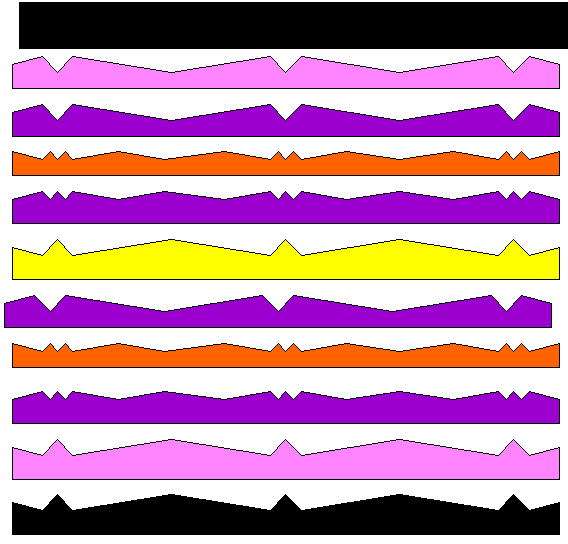
Now that you have your design and templates made, you need to get your fabric. My ribbonwork is made fro moire taffeta. I buy it by the yard and cut it into stripes. There are some suppliers that sell fabric pre-cut.
To begin cutting the fabric, I wet the ribbon, then place it on a board.
Clamp the template on top of the fabric.
The use a razor blade to cut a line from the bottom of each template valley to the end of the fabric.
After each cut is made, fold the fabric back onto the template and iron down.
The above photo shows how the fabric will look after ironing.
Remove the clamps and set the fabric to the side to dry. I usually let mine dry overnight.
Next step is to begin sewing.
You will sew down each piece one at a time. I use fabric glue on the tips of the fabric to hold it in place while I sew. You will sew along the edge of the new fabric using the same color thread.
Leave the last piece's edge to mount that to the wool.
Here is a photo of the finished set.
Please let me know if you have any questions or concerns.
Have you made any ribbonwork suits? Please share your work!
Here is the finished suit being worn!
Design was done by Orville Gates.
Last Updated on June 2, 2020 by Paul G
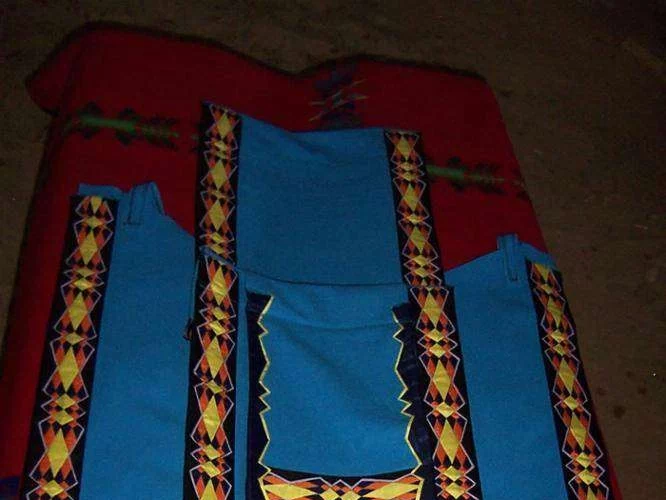

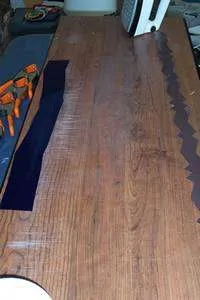
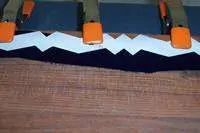
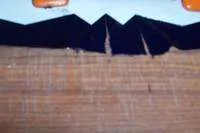
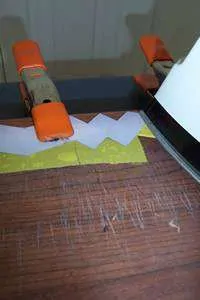
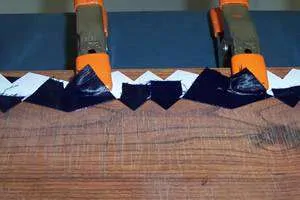
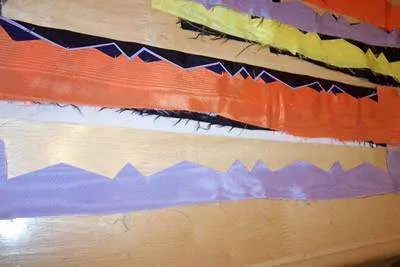



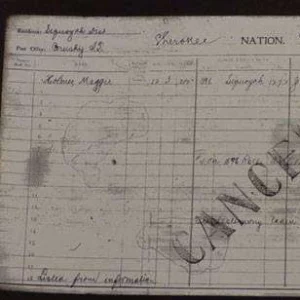
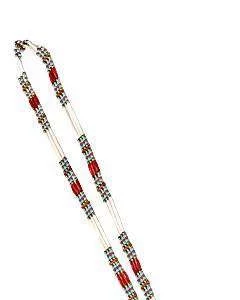
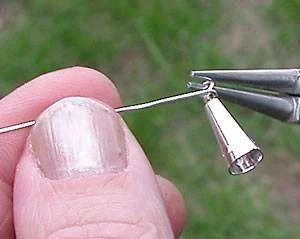
Susan DesJarlait
says:I’m so glad you reposted this! I bead & quill (sort of…lol) but was really mystified about how all the intricate folds & curves were done. I really wanted to make ribbon shirts for my sons & this really gives me the encouragement to try! Chi Miigwech for sharing 😊
Katherine Sinclair
says:Very useful. I’ve always wanted to try ribbon work. This gives me courage to try
Muriel Fite
says:Pendleton
Topstitch
says:A couple of questions, please.
First question, do you use a straight stitch or a zig-zag stitch when you are sewing the ribbon down? Second question, where do you purchase the taffeta for your ribbonwork?
I have a suggestion. There is a product called ‘Fray Check’. I have used it to help keep the edges from fraying . Plus it is washable & non-staining.
Paul G
says:Yes, I have used Fray Check on the ribbon ends.
I use a straight stitch to sew down the ribbons.
I purchased most of my taffeta at a local store in Columbia, SC. They had moire taffeta that was awesome! They even were able to order some special colors.
It is called House of Fabrics – https://www.facebook.com/chezfabrique/
Mary Green
says:Oops…Flower Moon!
Mary Green
says:Just beautiful. I finished read8ng Killer of the Moon Flower and have been look8ng at various Indian arts. I believe I may be a smidgen Native American thru my Canadian French maternal grandmother. I am a quilter and think I shall have to give this a try. Thank you for your great tutorial.
Darlene anderson
says:I really love ur work awesome stuff i hope to be as good as u
Lena
says:Does it have to be tin, because when I do my I use card board, or file folders?
And I use wonder under, some people use heat and bond, but that become too thick when u stack them.
Another question is why do u wet the fabric?
Paul G
says:I don’t use cardboard because I wet the fabric. I was taught to wet the fabric to get a better fold when ironing.
Rita Gonsalves
says:What’s the length and width of the templates? Thanks for the tutorial -Rita
Paul G
says:About 30 inches long and about 4 inches wide.
Mikki Kas
says:I have made myself a couple of ribbon dresses with the hanging ribbon streamers. My question is, how do you (or maybe you don’t) finish the end of the hanging ribbon streamers without it unraveling in the wash. The dresses and the ribbon used is washable but I’m afraid of the hanging pieces all coming apart with unraveling. I would appreciate some ideas here. Thank you!
Peni Beni
says:You burn the edges with a match or lighter. Just pass the edge of the ribbon through the flame very quickly. It will seal the edges so they don’t fray.
Faith Pegahmgabow
says:I am going to try this.
Saint Arroman
says:I didn’t do a real regalia but I made ( between other things) a wall hanging after one of your pictures I am quite proud of. I enjoy the ribbon work more and more.
Millie Roberts
says:hello..thanks for the written instructions, now am wondering if you are thinking of doing a tutorial for the ribbon work,explaining verbally step by step how to cut and fold…
Monica Alexander
says:Hello! I am a Native bead worker, and am hoping to learn how to do cut and fold ribbon work. I’ve been reading your tutorial, but am not seeing any dimensions…How long are the templates? I really need inches and such…thanks!
mona
says:I wish you could have a youtube tutorial.
Paul G
says:Great idea! I might have to do that soon!
William Gilbert
says:also what is the width of the template?
Paul G
says:About 3-4 inches. That isn’t as important. You just want to have it wide enough to be able to clamp it down.
William Gilbert
says:What is the length of the metal templates? 12″ or longer?
Paul G
says:I make mine as long as a legging strip if possible. Sometimes I’ve made them about 6-8″ long, but then you have to move the template several times for the long strips. It’s much easier to have it the longest length you’ll need.
Leaf
says:Thank you Paul G.
yolanda estep
says:Very interesting…My grandmothers taught me the beadwork and quillwork…but no longer living…nice to have the info.
Joy D
says:Thank you for this valuable info. Your work is beautiful.
Greg Bergenske
says:Lets not forget that every great piece of ribbon work needs edge beading.
It’s the little stuff that make straight suits so speial.
The craft world need good ribbon workers.
– WBS/Water Boy
Paul G
says:So true Greg!
Leaf
says:What do you use to cut the flashing with?
Paul G
says:I’ve cut them two different ways. Usually with tin snips. But I’ve also used a rig setup by some friends. They put a cutter on the end of a drill press. That gave much better, precise cuts.
Sonia Desnomie
says:It would be really nice if someone can post a tutorial on how to make a baby moss bag…Thanks
tobias grant
says:Thanks for sharing this blog, i am interested in ribbon work and this gives me a starting place for that.
Catherine Al-Meten
says:Thank you for posting this. Beautiful work, and very clear, detailed instructions. I look forward to trying my hand at this beautiful art.